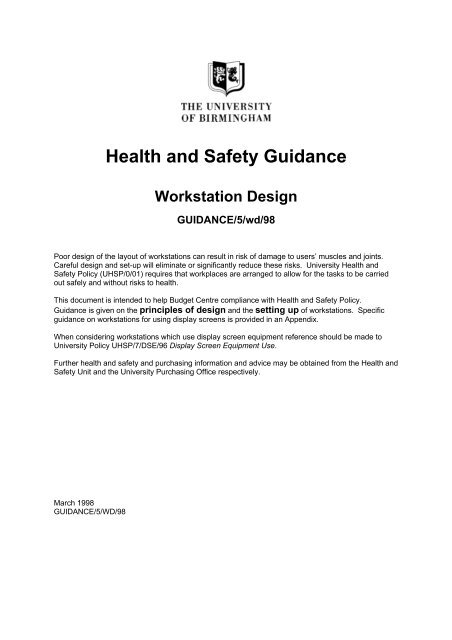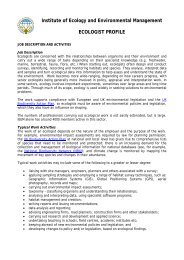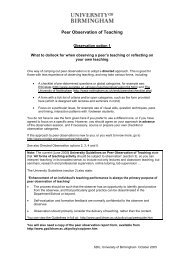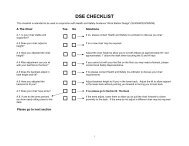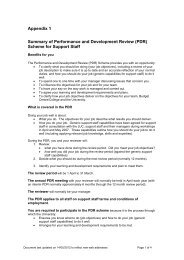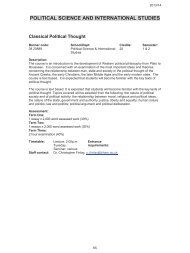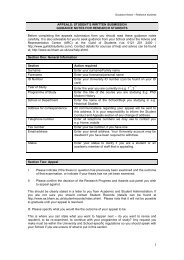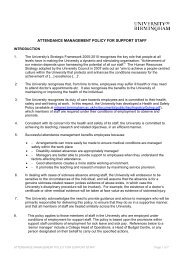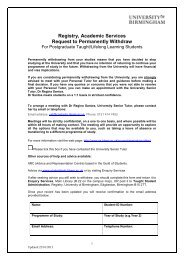Workstation design -University guidance (PDF 143KB)
Workstation design -University guidance (PDF 143KB)
Workstation design -University guidance (PDF 143KB)
Create successful ePaper yourself
Turn your PDF publications into a flip-book with our unique Google optimized e-Paper software.
Health and Safety Guidance<br />
<strong>Workstation</strong> Design<br />
GUIDANCE/5/wd/98<br />
Poor <strong>design</strong> of the layout of workstations can result in risk of damage to users’ muscles and joints.<br />
Careful <strong>design</strong> and set-up will eliminate or significantly reduce these risks. <strong>University</strong> Health and<br />
Safety Policy (UHSP/0/01) requires that workplaces are arranged to allow for the tasks to be carried<br />
out safely and without risks to health.<br />
This document is intended to help Budget Centre compliance with Health and Safety Policy.<br />
Guidance is given on the principles of <strong>design</strong> and the setting up of workstations. Specific<br />
<strong>guidance</strong> on workstations for using display screens is provided in an Appendix.<br />
When considering workstations which use display screen equipment reference should be made to<br />
<strong>University</strong> Policy UHSP/7/DSE/96 Display Screen Equipment Use.<br />
Further health and safety and purchasing information and advice may be obtained from the Health and<br />
Safety Unit and the <strong>University</strong> Purchasing Office respectively.<br />
March 1998<br />
GUIDANCE/5/WD/98
CONTENTS<br />
Page<br />
INTRODUCTION<br />
1. Application of the <strong>guidance</strong> 1<br />
GUIDANCE<br />
1. Who is the <strong>guidance</strong> aimed at? 1<br />
2. General principles 1<br />
3. Design considerations for standing workstations 2<br />
4. Design considerations for seated workstations 2<br />
5. Design considerations for tables and desks 4<br />
6. Other <strong>design</strong> consideration for workstations 4<br />
APPENDICES<br />
1. Design of seated and standing workstations 6<br />
2. Further advice and information 10
INTRODUCTION<br />
APPLICATION OF THE GUIDANCE<br />
The <strong>guidance</strong> applies to all places where people work at a static location. This includes workstations<br />
where people are required to stand or sit. It also gives <strong>guidance</strong> on general considerations for all<br />
workplaces. Appendix 1 deals particularly with personal computers and other display screen<br />
equipment.<br />
The <strong>guidance</strong> is based on ergonomic principles and sets down a basis for the <strong>design</strong> and use of new<br />
and currently existing workstations. The aim is to avoid damage to muscles and joints from poor<br />
<strong>design</strong> of the workstation. The back, neck, shoulders and upper limbs are particularly at risk.<br />
Discomfort will result from a poor workstation <strong>design</strong> and if this continues over a period of time it may<br />
result in permanent damage to health.<br />
This <strong>guidance</strong> is aimed at those who:<br />
GUIDANCE<br />
1. WHO IS THE GUIDANCE AIMED AT?<br />
• purchase or order furniture;<br />
• <strong>design</strong> workstations;<br />
• construct or set up workstations;<br />
• supervise staff at workstations;<br />
• advise on health and safety in their Budget Centres.<br />
2. GENERAL PRINCIPLES<br />
When <strong>design</strong>ing a workstation the activity and the posture required to carry out that activity should be<br />
considered. Ill health can arise from:<br />
• poor work position and posture;<br />
• high levels of force (e.g. punching holes, undoing tight screws);<br />
• high levels of repetition (e.g. pipetting, typing, assembly work);<br />
• awkward manual handling tasks;<br />
• excess bending, stretching or effort.<br />
To minimise the risk of ill health the following general principles should be applied:<br />
• assess the task to minimise the amount of physical work, (e.g. automate, use correctly<br />
<strong>design</strong>ed equipment);<br />
• assess who is going to use the workstation, (e.g. able bodied or disabled, exceptionally short<br />
or tall);<br />
• where possible, keep the body posture in a neutral position, (e.g. no twisting of the neck or the<br />
back and no bent wrists). This will reduce the amount of physical stress on the body and if<br />
strength is required, muscles can exert greater force in a neutral position;<br />
• avoid bending the head and neck forward to look at work as this requires the neck muscles to<br />
support the head;<br />
• avoid bending the trunk forward as in this position, the upper body has to be held up by the<br />
back and shoulder muscles;<br />
• avoid holding the arms and hands in a raised position;<br />
1
• avoid twisting of the body;<br />
• allow for changes in posture and movement. It is unnatural for the human body to be held in<br />
one position for a sustained period of time.<br />
When carrying out any workstation <strong>design</strong> an early decision needs to be made about whether the<br />
operator should be standing or seated or given the opportunity to do both. <strong>Workstation</strong>s can be<br />
<strong>design</strong>ed for both standing and sitting. This will allow the user to change position and alter posture<br />
more regularly, which is helpful in preventing discomfort or long-term problems.<br />
3. DESIGN CONSIDERATIONS FOR STANDING WORKSTATIONS<br />
Examples at the <strong>University</strong>:<br />
laboratory benches<br />
workshop benches<br />
computer stations<br />
sorting tables<br />
food preparation tables<br />
food serveries<br />
wash up areas<br />
stores distribution point<br />
book distribution points<br />
photocopiers<br />
printing machines<br />
collating tables<br />
The height of the work surface is vital and depends on the task being carried out. If the work surface<br />
is too low, the user will have to bend over to work, if the work surface is too high then the user will<br />
have to raise their arms which puts undue pressure on the shoulders.<br />
Although it is not possible to fit a workstation height to all members of the population, in general, it is<br />
possible to fit the middle 90% of the population.<br />
The general recommended heights for work surfaces is between 95cm to 110cm from the floor.<br />
However the height of the work bench will also depend on the task being carried out.<br />
For tasks which require precision, the work should be positioned 5cm to 10cm below elbow height.<br />
For those classified as light work, for example requiring little force, the work should be positioned<br />
between 10cm and 15cm below elbow height. For tasks classified as heavier work and requiring more<br />
force to carry them out, the working surface should be 15cm to 40cm below elbow height. (See<br />
Appendix 1, figure 3)<br />
If possible adjustability should be built into workbenches. However, where this is not possible, raising<br />
the floor level should be considered for shorter users.<br />
4. DESIGN CONSIDERATIONS FOR SEATED WORKSTATIONS<br />
Advantages of seated work<br />
• takes the weight of the legs;<br />
• can avoid unnatural body postures;<br />
• reduces energy consumption;<br />
• puts fewer demands on the cardiovascular system.<br />
Disadvantages of seated work<br />
• restricts mobility;<br />
• cannot use large hand forces;<br />
• causes slackening of the stomach muscles;<br />
• causes curvature of the spine.<br />
Basic Requirements for Seating<br />
• support the worker in a position in which he or she can work comfortably and efficiently;<br />
• allow the worker to change position easily and without losing support;<br />
2
• prevent the seat pan from compressing the buttocks or the thighs;<br />
• cater for special needs, e.g., short, tall, disabled, well built;<br />
• the seat should suit the workstation including the height of the work surface, layout of the<br />
furniture and other equipment;<br />
• should have a back rest.<br />
Seat pan<br />
Should be adjustable for height between 38cm and 53cm from the floor to allow the user to sit with<br />
their legs at 90° and their feet flat on the floor. If the user is particularly short and their feet cannot<br />
comfortably rest on the floor then an adjustable foot rest will be required. If the height of the work<br />
surface is higher than normal then users should be able to adjust the seat pan upwards. Again there<br />
may be need for a footrest.<br />
The seat surface should be padded especially at the front to prevent it from cutting into the back of the<br />
knee.<br />
Seat Width<br />
Should be a minimum of 40cm.<br />
Seat Depth<br />
Should be <strong>design</strong>ed to allow all sitters to use the backrest. The maximum length of the seat depth is<br />
43cm measured from the front edge of the backrest to the front of the seat pan. Providing the seat<br />
height is adequate all users should be able to sit comfortably.<br />
Upholstery<br />
The cushioning should compress down by 1cm to 2cm when pressed by hand. If too soft cushioning<br />
will not give any support to the buttocks or the backs of the thighs. If too hard may cause compression<br />
on the buttocks. Contouring the seat may help reduce compression. The type of material used to<br />
cover the seat will be dependant on where the seat is to be used. E.g. in the case of a laboratory<br />
where liquids are used which could contaminate the seat an impermeable material should be<br />
specified. This is particularly important where radioisotopes and microorganisms<br />
are handled.<br />
Seat Angles<br />
The angle of the seat pan may either be forward tilting, backward tilting or flat. A forward tilting chair<br />
may be of use where the worker needs to reach forward or is carrying out precise work. However<br />
forward tilting will result in slippage if the wrong upholstery materials are used. Users sitting in a<br />
forward tilting position will need to use their legs to support themselves therefore it is essential that<br />
feet reach the floor or they have an adequate footrest. Backward tilting seats push the user against<br />
the backrest and prevent slipping from the chair. When using flat seat pans, users must be<br />
encouraged to use the backrest correctly.<br />
Backrests<br />
There are generally two types of backrest. Low, which support the lumbar region only and high, those<br />
that support the head and neck. For high backrests the rest should extend to the tallest person's<br />
shoulder height. Unless a high backrest is used, the backrest should be adjustable. Recommended<br />
measurements include the height from the seat pan to the mid backrest of 17cm to 30cm. The<br />
backrest should be contoured to the shape of the spine and give support to the lumbar curve (lower<br />
3
ack). The lumbar support should stand out 4cm from the backrest as this gives a similar curve to that<br />
in people in the standing position.<br />
The backrest angle has two functions. It prevents the occupant slipping forward and<br />
helps the body lean against the backrest with lumbar support. For reaching, the backrest angle should<br />
be between 101° to 104° as required, and for relaxing between 105° to 108°, measured from along the<br />
seat pan.<br />
Interaction of the Seat with the <strong>Workstation</strong><br />
It is vital that any seat interacts correctly with the workstation it is used with. <strong>Workstation</strong> height is<br />
important but with an adjustable chair the main concern is that the largest and smallest users can fit<br />
the workstation. If the chair has arms it is important that the arms do not impede the comfortable use<br />
of the workstation. E.g., arms may prevent the chair being able to be drawn up close enough to a<br />
desk. A chair with adjustable height arms may need to be considered.<br />
5. DESIGN CONSIDERATIONS FOR TABLES AND DESKS<br />
The dimensions of tables and desks should allow the user to sit comfortably and have enough space<br />
on the top surface to allow all required equipment to be kept and used safely. If the table is too small,<br />
it is often difficult to work using safe posture. Before any new <strong>design</strong> is chosen, the tasks that are to<br />
be carried out and the equipment required should be considered, preferably with the intended user, to<br />
ensure that there will be adequate space for everything.<br />
The height of the underside of a table or desk should be 66cm or more from the floor.<br />
Reaching<br />
6. OTHER DESIGN REQUIREMENTS FOR WORKSTATIONS<br />
<strong>Workstation</strong>s should be <strong>design</strong>ed to avoid excessive reaching. (See Appendix 1, figure 4.)<br />
Any equipment used frequently by the staff member should be within a radius of 50cm of the user. As<br />
a practical guide the individual can stretch their arms in front of them and draw imaginary arcs at their<br />
workstation. Most items frequently used should be within that area.<br />
The most important pieces of equipment should be closest to the user during work tasks.<br />
Lighting<br />
Lighting has four main purposes:<br />
• to ensure the safety of people;<br />
• to ease the performance of tasks;<br />
• to create an appropriate visual environment;<br />
• to avoid eye-strain.<br />
There should be adequate light in a working environment to allow particular work tasks to be carried<br />
out and recommended illumination levels for specific work tasks are available (Ref to Lighting at Work,<br />
HS(G)38). Where possible, natural lighting should be used. There is however little control over<br />
daylight and it is recommended that blinds be used on windows to reduce glare and reflection<br />
problems from the sun.<br />
For both natural and supplied lighting, it is vital that glare should be avoided. This can be carried out<br />
by the careful positioning of workstations and lighting in relation to each other. Reflection from work<br />
surfaces can also create problems in seeing work tasks and can be reduced by using furniture and<br />
equipment with low reflectance surfaces.<br />
4
In some cases task or local lighting may be appropriate to ensure an adequate source of light. Care<br />
must be taken to ensure that localised lighting is not causing a problem with glare to other workers<br />
nearby.<br />
Space<br />
There should be sufficient space to access the workstation safely and conveniently and prevent<br />
interference between workstations. In offices the minimum space per person should be 11m 3 ,<br />
disregarding any space more than 3m above the floor.<br />
Temperature and ventilation<br />
The temperature and ventilation in an indoor workplace should allow for reasonably comfortable<br />
working conditions. The minimum temperature for sedentary work after the first hour of work should<br />
be 16°C and there should be an adequate supply of fresh air.<br />
Noise<br />
Noise levels should be kept as low as possible including irritating noises. If the noise level is 85db or<br />
more a noise survey should be carried out.<br />
Flooring<br />
Flooring should be suitable for the work being carried out. It should be non slip, easy to clean and not<br />
be prone to damage.<br />
5
APPENDIX 1<br />
Design of workstations<br />
Design of seated workstation:<br />
Rear view Figure 1<br />
Side view Figure 2<br />
Design of workbench<br />
Standing heights Figure 3<br />
Bench layout Figure 4<br />
6
Design of seated workstations<br />
Figure 1<br />
Typical Seated <strong>Workstation</strong> (rear view)<br />
(The display screen equipment could be replaced by other seated tasks)<br />
The main diagram shows the document holder in front of the person and the display screen to one<br />
side. This is the correct arrangement for a person who works almost exclusively from documents and<br />
only occasionally looks at the screen. E.g. a touch typist.<br />
The inset diagram shows the document holder and display screen in front of the person. This is the<br />
correct position for a person who frequently looks at both documents and the screen.<br />
Key points:<br />
1 Adequate lighting<br />
2 Adequate contrast, no glare or distracting reflections<br />
3 Distracting noise minimised<br />
4 Leg room and clearances to allow postural changes<br />
5 Window covering<br />
6 Software: appropriate to task and adapted to user<br />
7 Screen: stable image, adjustable, readable and glare and reflection free<br />
8 Keyboard: usable, adjustable, detachable and legible<br />
9 Work surface: allow flexible arrangements, spacious (0.4m 2 ) and glare free<br />
10 Work chair: adjustable<br />
11 Footrest: adjustable<br />
12 Document holder: adjustable<br />
13 Often used equipment (e.g. telephone): accessible without stretching<br />
7
Figure 2<br />
Typical Seated <strong>Workstation</strong> (side view)<br />
(The display screen equipment could be replaced by other seated tasks)<br />
Key points<br />
1 Seat back adjustability<br />
2 Good lumber support<br />
3 Seat height adjustability<br />
4 No excess pressure on underside of thighs and backs of knees<br />
5 Foot support if required<br />
6 Space for postural change, no obstacles under desk<br />
7 Forearms approximately horizontal<br />
8 Minimal extension, flexion or deviation of wrists<br />
9 Screen height, angle and distance should allow comfortable head position without eye strain<br />
10 Space in front of keyboard to support hands and wrists during pauses in keying<br />
8
Design of workbenches<br />
Figure 3<br />
Recommended heights of benches for standing work<br />
Figure 4<br />
Recommended position of articles on a bench top<br />
Where possible, all materials, tools, controls and containers should be within this area<br />
9
APPENDIX 2<br />
FURTHER ADVICE<br />
If there is an ergonomic problem with an existing workstation or possible problem with a planned<br />
workstation then the Health and Safety Unit will be able to advise.<br />
If new workstations are to be purchased advice and a list of approved suppliers can be obtained from<br />
the <strong>University</strong> Purchasing Office.<br />
FURTHER SOURCES OF INFORMATION<br />
Standards<br />
BS 7179 Ergonomics of <strong>design</strong> and use of visual display terminals (VDTs) in offices Parts 1 to 6.<br />
HSE Publications<br />
HSE, Work equipment. Guidance on the Provision and Use of Work Equipment Regulations L22,<br />
1992, HSC.<br />
HSE, Guidance on the Workplace Health, Safety and Welfare Regulations L24, 1992, HSC.<br />
HSE, Work related upper limb disorders: a guide to prevention, HS(G)60, 1990, HMSO.<br />
HSE, Ergonomics at work, IND(G)90L, HMSO.<br />
HSE, A pain in your workplace: ergonomic problems and solutions, 1994, HSE.<br />
HSE, Lighting at Work HS(G)38, 1998, HMSO.<br />
HSE, Seating at Work HS(G)57, 1998, HMSO.<br />
Books<br />
Dul, J. and Weerdmeester, B., 1993, Ergonomics for beginners: A quick reference guide, Taylor and<br />
Francis, London.<br />
Grandjean, E., 1988, Fitting the task to the man: A textbook of occupational ergonomics, Taylor and<br />
Francis, London.<br />
Oborne, D.J., 1987, Ergonomics at work, John Wiley and Sons, Winchester.<br />
g:\aww7text\<strong>guidance</strong>\5wd.doc<br />
16 July 2002<br />
10


